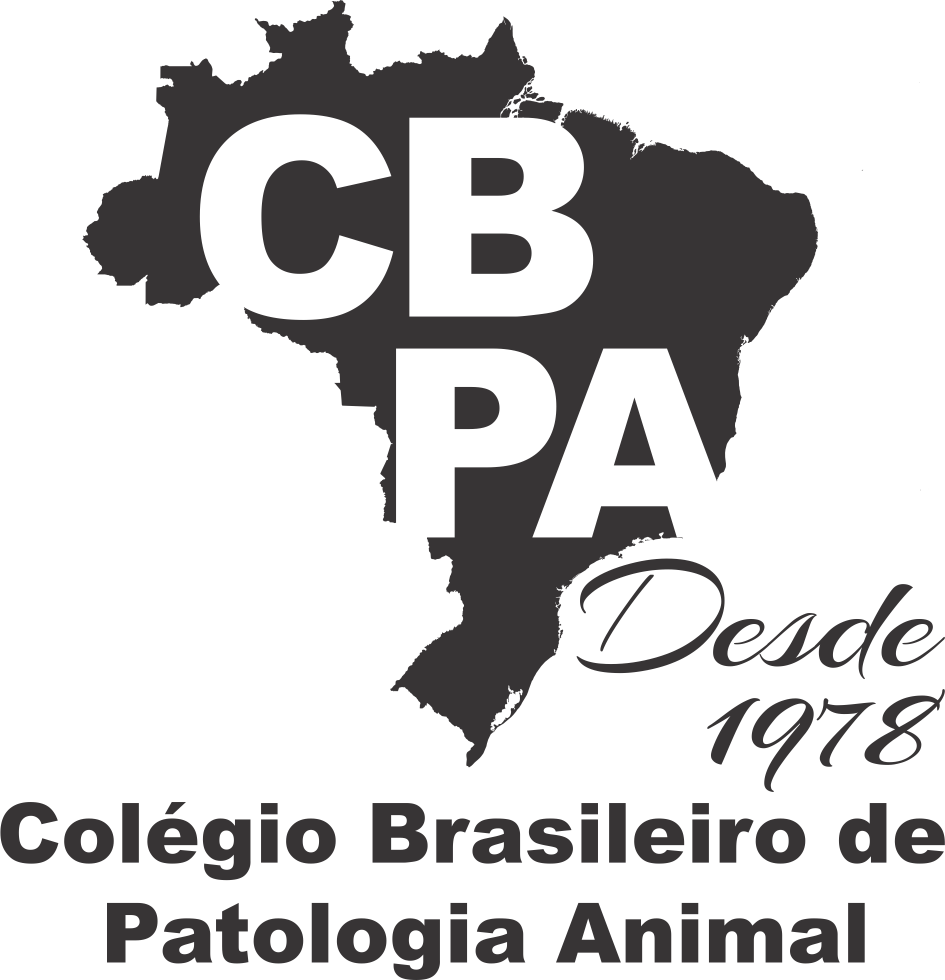Resultado da pesquisa (3)
Termo utilizado na pesquisa lesões podais
#1 - Characterization and frequency of foot injuries and foot-related lameness in a sheep herd with prophylactic measures for foot-related diseases
Abstract in English:
ring locomotion interferes with feeding and behavior, leading productivity losses. The objective of this work was to describe the main foot disease found in sheep herd that uses prophylactic measures against foot diseases. A total of 346 ewes of different ages, with or without lameness, were assessed for the presence of foot lesions in all limbs, digits and adjacent structures. Among all the 2768 digits evaluated, 103 (29.76%) had lesions, representing 1.04 lesion per animal. 41.75% (43/103) had only one lesion, 39.81% (41/103) had two lesions, 16 (15.53%) had three lesions, and only 2.91% (3/103) had four or more lesions. Hind limbs were the most affected and the most frequent diseases were white line disease (40.05%), interdigital dermatitis (33.70%) and footrot (12.15%). It was concluded that foot disease in sheep is frequent and constitute a health problem for herds, even on farms that use strategies to prevent it. Therefore, it is essential to classify the lesions, as well as the adoption of effective prophylactic and therapeutic measures.
Abstract in Portuguese:
Lesões podais em ovinos são responsáveis por grandes perdas econômicas, pois a dor durante a locomoção interfere na alimentação e no comportamento, levando à perda de produtividade. O objetivo deste trabalho foi descrever as principais doenças podais encontradas em rebanho ovino, que utiliza medidas profiláticas contra as doenças podais. Foram examinadas 346 ovelhas quanto à presença de lesões podais em todos os membros, dígitos e estruturas adjacentes. Entre os 2.768 dígitos avaliados, 103 (29,76%) apresentavam lesões, representando 1,04 lesões por animal. 41,75% (43/103) apresentavam apenas uma lesão, 39,81% (41/103) tinham duas lesões, 16 (15,53%) tinham três lesões, e apenas três animais apresentavam quatro ou mais lesões. Os membros posteriores foram os mais afetados e as doenças mais frequentes foram a doença da linha branca (40,05%), dermatite interdigital (33,70%) e footrot (12,15%). Pode-se concluir que as lesões podais em ovinos são frequentes e constituem um problema sanitário para os rebanhos, mesmo em propriedade que realiza medidas profiláticas. Portanto, é fundamental classificar as lesões, assim como adotar as medidas profiláticas e terapêuticas eficazes.
#2 - Foot lesions of sheep from southwestern Rio Grande do Sul, 36(10):971-978
Abstract in English:
ABSTRACT.- Silveira C.S., Damboriarena P.A., Morais R.M., Trost M.E., Pozzobon R. & Anjos B.L. 2016. [Foot lesions of sheep from southwestern Rio Grande do Sul.] Lesões podais em ovinos da Mesorregião Sudoeste do Rio Grande do Sul. Pesquisa Veterinária Brasileira 36(10):971-978. Laboratório de Patologia Veterinária, Universidade Federal do Pampa, Uruguaiana, RS 97500-970, Brazil. E-mail: anjosbl@gmail.com
Foot lesions in sheep are important causes of economic loss due to fall in productivity, reproduction, by spending on ineffective treatment and elimination of affected animals. The purpose of this study was described the main features of foot lesions of sheep from southwestern Rio Grande do Sul, as well as epidemiological aspects and the importance of occurrence of these lesions for sheep farming in the region. Epidemiological and clinic-pathological information of sheep herds from the region between April 2014 and April 2015, by means of visits to farms. In the study were evaluated 27 sheep flocks on farms located in different municipalities. In 21 farms was reported occurrence of foot lesions in sheep having caused significant economic losses. About 1700 sheep, 10% of herds, showed different degree of lameness caused by foot lesions ranging from mild to severe. It was found that several factors, such as climate and breeding were favorable for the development of foot injuries which may be associated with different disorders and etiologic agents. Although these injuries are important, the control and prevention has proved ineffective. Also was observed that infectious pododermatitis (Footrot) may be the main foot disease of sheep in the region, and can be considered a neglected disease.
Abstract in Portuguese:
RESUMO.- Silveira C.S., Damboriarena P.A., Morais R.M., Trost M.E., Pozzobon R. & Anjos B.L. 2016. [Foot lesions of sheep from southwestern Rio Grande do Sul.] Lesões podais em ovinos da Mesorregião Sudoeste do Rio Grande do Sul. Pesquisa Veterinária Brasileira 36(10):971-978. Laboratório de Patologia Veterinária, Universidade Federal do Pampa, Uruguaiana, RS 97500-970, Brazil. E-mail: anjosbl@gmail.com
Lesões podais em ovinos são causas importantes de perdas econômicas por quedas na produtividade, na reprodução, por gastos com tratamentos ineficientes e com o descarte de animais afetados. Dessa forma, os objetivos foram descrever as principais características das lesões podais observadas em ovinos da Mesorregião Sudoeste do Rio Grande do Sul, seus aspectos epidemiológicos e a importância da ocorrência desses distúrbios para a criação de ovinos nessa região. Foram coletados dados epidemiológicos e clinicopatológicos de rebanhos ovinos da região entre abril de 2014 e abril de 2015 através de visitas técnicas em propriedades rurais. Foram avaliados rebanhos ovinos em 27 propriedades rurais localizadas em diferentes municípios, dos quais 21 registraram a ocorrência de lesões podais com relato de perdas econômicas significativas. Aproximadamente 1.700 ovinos, em média 10% dos rebanhos, apresentavam diferentes graus de claudicação decorrente de lesões podais que variavam de brandas a severas. Verificou-se que diversos fatores como clima e manejo foram favoráveis para o desenvolvimento das lesões podais e essas podem estar associadas a diferentes distúrbios e agentes etiológicos. No entanto, embora essas condições sejam importantes, o controle e a prevenção tem se mostrado ineficientes. Observou-se ainda que a pododermatite infecciosa dos ovinos (Footrot), parece ser a principal doença podal na região e atualmente pode ser considerada uma doença negligenciada.
#3 - Foot rot and other foot diseases of goat and sheep in the semiarid region of northeastern Brazil, 31(10):879-884
Abstract in English:
ABSTRACT.- Aguiar G.M.N., Simões S.V.D., Silva T.R., Assis A.C.O., Medeiros J.M.A., Garino Jr F. & Riet-Correa F. 2011. Foot rot and other foot diseases of goat and sheep in the semiarid region of northeastern Brazil. Pesquisa Veterinária Brasileira 31(10):879-884. Hospital Veterinário, Universidade Federal de Campina Grande, Patos, PB 58700-000, Brazil. E-mail: franklin.riet@pq.cnpq.br
This paper reports the occurrence and epidemiology of outbreaks of foot rot and other foot diseases in goats and sheep in the semiarid region of Paraíba, northeastern Brazil. Four farms were inspected for the presence of foot lesion in sheep and goats and for environmental conditions, general hygiene, pastures, and disease control measures. The prevalence of foot lesions was 19.41% (170/876) in sheep and 17.99% (52/289) in goats, ranging between 5.77% and 33.85% in different farms. Foot rot was the most common disease, affecting 12.1% of the animals examined (141/1165), but with significantly higher (p<0.05) prevalence in sheep (13.69%) than in goats (7.27%). The frequency of malignant foot rot was also significantly lower (p<0.05) in goats (9.53%) than in the sheep (40.83%). On one farm, Dorper sheep showed significantly higher (p<0.05) prevalence of foot rot (17.5%) than Santa Inês sheep (6.79%), and the number of digits affected was also higher in the former. Dichelobacter nodosus and Fusobacterium necrophorum were isolated from cases of foot rot. White line disease was found in 3.95% of the animals, sole ulcers in 1.29%, foot abscess in 1.03% and hoof overgrowth in 0.5%. The high rainfall at the time of occurrence, grazing in wetlands, clay soils with poor drainage, presence of numerous stony grounds, closure of the flocks in pens at night, and introduction of affected animals were considered predisposing factors for the occurrence of foot diseases.
Abstract in Portuguese:
RESUMO.- Aguiar G.M.N., Simões S.V.D., Silva T.R., Assis A.C.O., Medeiros J.M.A., Garino Jr F. & Riet-Correa F. 2011. Foot rot and other foot diseases of goat and sheep in the semiarid region of northeastern Brazil. [Pododermatite infecciosa e outras doenças podais de caprinos e ovinos no semiárido Nordestino.] Pesquisa Veterinária Brasileira 31(10):879-884. Hospital Veterinário, Universidade Federal de Campina Grande, Patos, PB 58700-000, Brazil. E-mail: franklin.riet@pq.cnpq.br
Este trabalho relata a ocorrência e aspectos epidemiológicos de surtos de pododermatite infecciosa e outras afecções podais em caprinos e ovinos no semiárido paraibano. As propriedades foram inspecionadas quanto à presença de problemas podais e aspectos relacionados às condições ambientais, higiene, locais de pastejo e medidas de controle utilizadas. Nos ovinos a prevalência de lesões podais foi de 19,41% (170/876) e nos caprinos de 17,99% (52/289), variando entre 5,77% e 33,85% nas diferentes propriedades. A pododermatite infecciosa foi a doença mais frequente acometendo 12,1% dos animais examinados (141/1165), sendo a prevalência nos ovinos (13,69%) significativamente maior (p<0,05) do que a nos caprinos (7,27%). A frequência de lesões malignas desta doença em caprinos (9,53%) foi, também, significativamente menor (p<0,05) do que nos ovinos (40,83%). Em uma das propriedades a prevalência de pododermatite infecciosa entre os ovinos Dorper (17,5%) foi significativamente maior do que a nos ovinos da raça Santa Inês (6,79 %), tendo os animais da primeira raça maior número de membros acometidos pela pododermatite infecciosa. Dichelobacter nodosus e Fusobacterium necrophorum foram isolados de casos de pododermatite infecciosa. A doença da linha branca foi constatada em 3,95% dos animais, a úlcera de sola em 1,29%, o abscesso do pé em 1,03%, e crescimento excessivo do casco em 0,5%. Os altos índices pluviométricos na época de ocorrência, o pastejo em áreas úmidas, os solos argilosos com pouca drenagem, os terrenos pedregosos, o encerramento em currais durante a noite e a introdução de animais doentes foram considerados fatores predisponentes para a ocorrência dos surtos.








